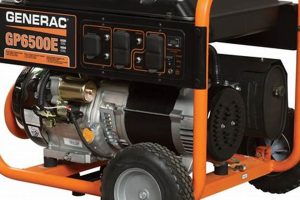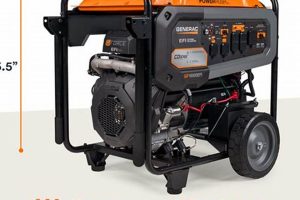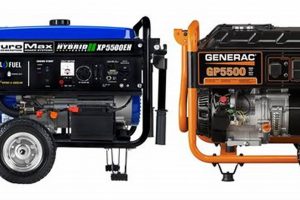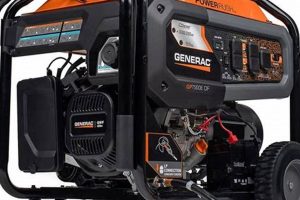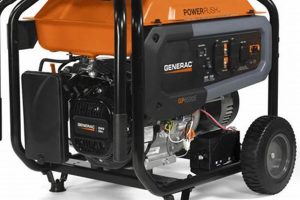A failure to initiate operation in a portable power generation unit manufactured by Generac represents a common issue encountered by users. This malfunction can manifest in various ways, from a complete lack of response to sputtering attempts at ignition. An example includes scenarios where the engine cranks but fails to fully ignite and sustain operation.
Understanding the reasons behind these starting problems is crucial for maintaining reliable power supply during outages or in off-grid situations. Troubleshooting and resolving these issues can prevent costly repairs, minimize downtime, and ensure the generator’s longevity. Historically, improvements in engine design, fuel systems, and starting mechanisms have addressed many common starting problems, but challenges can still arise due to factors like maintenance neglect, environmental conditions, or fuel quality.
This article will explore potential causes for such starting failures, ranging from simple fixes like low fuel levels or clogged air filters to more complex issues involving the engine’s ignition or fuel systems. Furthermore, it will offer practical troubleshooting steps and guidance on preventive maintenance to minimize future occurrences.
Troubleshooting a Non-Starting Generac Portable Generator
Systematic troubleshooting offers a practical approach to resolving starting failures in Generac portable generators. The following tips outline a logical process of elimination to pinpoint the underlying cause.
Tip 1: Fuel Level Check: Verify sufficient fuel is present in the tank. An empty or near-empty fuel tank is a common cause of starting issues.
Tip 2: Fuel Shutoff Valve: Ensure the fuel shutoff valve is in the open (or “ON”) position. This valve controls fuel flow to the engine and, if closed, will prevent starting.
Tip 3: Choke Operation: Use the choke appropriately. In colder temperatures or after extended periods of non-use, engaging the choke enriches the fuel mixture for starting. Ensure it’s disengaged once the engine warms up.
Tip 4: Air Filter Inspection: A clogged air filter restricts airflow to the engine, hindering combustion. Inspect the air filter for excessive dirt or debris and clean or replace as needed.
Tip 5: Spark Plug Examination: Remove and inspect the spark plug(s). Check for fouling, damage, or excessive wear. Clean, gap, or replace the spark plug as required.
Tip 6: Battery Condition: A weak or dead battery prevents the engine from cranking. Test the battery voltage and recharge or replace if necessary. Clean battery terminals to ensure good connections.
Tip 7: Oil Level Check: Verify the engine oil is at the correct level. Low oil can trigger a safety shutdown preventing the generator from starting.
By systematically addressing these potential issues, one can often restore functionality without professional intervention. Proper maintenance and adherence to manufacturer guidelines significantly reduce the likelihood of future starting problems.
These troubleshooting tips provide a starting point for diagnosing and resolving starting issues. If problems persist, consultation with a qualified technician is recommended for further diagnosis and repair.
1. Fuel System
The fuel system plays a critical role in the operation of a Generac portable generator. A malfunction within this system is a frequent cause of starting failures. Understanding its components and their functions is essential for effective troubleshooting.
- Fuel Delivery
Fuel delivery involves the path from the fuel tank to the engine’s combustion chamber. This includes the fuel tank, fuel lines, fuel pump, and carburetor. A blockage in the fuel line, a malfunctioning fuel pump, or a clogged carburetor jet can disrupt fuel flow and prevent the generator from starting. For example, stale gasoline can leave gummy deposits that obstruct fuel passage.
- Fuel Quality
Fuel quality significantly impacts engine performance and starting capability. Using old, contaminated, or incorrect fuel can lead to starting problems. Ethanol in gasoline can attract moisture and degrade over time, leading to engine damage and starting difficulties. Using the recommended fuel type and ensuring its freshness are crucial.
- Fuel Filter
The fuel filter prevents contaminants from entering the engine. A clogged fuel filter restricts fuel flow, mimicking the symptoms of a fuel pump issue or empty tank. Regular filter replacement, as specified in the generator’s maintenance schedule, prevents performance issues and starting failures.
- Carburetor
The carburetor mixes fuel and air in the correct proportions for combustion. A malfunctioning carburetor, due to clogging or improper adjustment, can lead to an overly rich or lean fuel mixture. Either condition can prevent the generator from starting or running smoothly. Regular cleaning and adjustment of the carburetor are important maintenance procedures.
Addressing these fuel system aspects often resolves starting problems. Careful attention to fuel quality, regular maintenance of fuel system components, and prompt attention to potential issues can significantly improve the reliability of a Generac portable generator.
2. Ignition System
The ignition system is crucial for initiating combustion within a Generac portable generator’s engine. A malfunctioning ignition system is a common culprit when the generator refuses to start. Understanding its components and their function is essential for effective troubleshooting.
- Spark Plug
The spark plug ignites the compressed fuel-air mixture within the combustion chamber. A fouled, worn, or improperly gapped spark plug can prevent ignition. Regular inspection and replacement, as outlined in the generator’s maintenance schedule, are essential for reliable operation. For example, a spark plug coated with carbon deposits may fail to produce a strong enough spark.
- Ignition Coil
The ignition coil generates the high voltage necessary to create the spark across the spark plug’s gap. A failing ignition coil can result in a weak spark or no spark at all, preventing the engine from starting. Testing the ignition coil with a multimeter can confirm its functionality.
- Spark Plug Wire
The spark plug wire transmits the high voltage from the ignition coil to the spark plug. Damaged or worn spark plug wires can leak voltage, reducing spark intensity or preventing the spark from reaching the plug. Inspecting the wires for cracks, burns, or loose connections is a crucial diagnostic step.
- Control Module (if equipped)
Some Generac generators utilize electronic control modules to manage the ignition system. A malfunctioning control module can disrupt spark timing or prevent spark generation altogether. Diagnosis of control module issues typically requires specialized diagnostic equipment.
A systematic check of these ignition system components often reveals the source of a starting problem. Regular maintenance, timely replacement of worn parts, and prompt attention to any signs of malfunction can prevent future starting failures and ensure the generator’s reliability.
3. Engine Condition
The overall mechanical health of the engine significantly impacts the starting capability of a Generac portable generator. A well-maintained engine, operating within its design parameters, starts reliably and delivers consistent power. Conversely, an engine suffering from mechanical issues may exhibit starting difficulties or fail to start altogether. Addressing underlying engine problems is crucial for restoring reliable operation.
- Compression
Adequate compression within the engine cylinders is essential for proper combustion. Low compression, often caused by worn piston rings or valves, reduces the engine’s ability to ignite the fuel-air mixture, leading to starting difficulties. A compression test can quantify cylinder pressure and identify potential problems. For instance, consistently low compression readings across multiple cylinders may indicate worn piston rings.
- Low Oil Level
Maintaining the correct oil level is crucial for engine lubrication and protection. Low oil levels can trigger safety mechanisms that prevent the engine from starting to avoid internal damage. This safeguard protects against catastrophic engine failure due to insufficient lubrication. Regularly checking and maintaining the correct oil level is a simple yet crucial preventative measure.
- Mechanical Wear and Tear
Over time, engine components experience wear and tear. Worn bearings, valves, or other internal parts can affect engine performance and hinder starting. Adhering to the manufacturer’s recommended maintenance schedule, including regular oil changes and periodic inspections, mitigates the effects of wear and tear and prolongs engine life. For example, worn valve guides can lead to reduced compression and starting problems.
- Overheating
Previous instances of engine overheating can damage internal components, impacting future starting performance. Overheating can warp cylinder heads or damage pistons, leading to compression loss and starting difficulties. Addressing the root cause of overheating is critical to prevent recurring problems and long-term engine damage. Ensuring adequate cooling and avoiding overloading the generator are crucial preventative measures.
Ignoring engine condition issues can lead to further complications and potentially catastrophic engine failure. Regular maintenance, prompt attention to warning signs, and timely repairs ensure reliable generator operation and extend its lifespan. Addressing these mechanical aspects often resolves starting difficulties and restores the generator to optimal performance. These mechanical issues often contribute directly to starting failures in Generac portable generators. Addressing them is essential for reliable operation.
4. Electrical Components
Electrical components play a vital role in the starting and operation of a Generac portable generator. A fault within the electrical system can manifest as a starting failure, necessitating systematic diagnosis to pinpoint the underlying issue. Understanding the function and potential failure points of key electrical components is essential for effective troubleshooting.
- Battery
The battery provides the initial electrical power to crank the engine. A weak or dead battery prevents the starter motor from turning the engine over, resulting in a starting failure. Cold weather can further exacerbate this issue by reducing battery capacity. Regular battery testing and replacement, especially in colder climates, are crucial for reliable starting. For example, a battery with low voltage may crank the engine slowly or not at all.
- Starter Motor
The starter motor, powered by the battery, engages with the engine’s flywheel to initiate rotation. A malfunctioning starter motor, whether due to mechanical wear or electrical faults, can prevent the engine from cranking. A clicking sound when attempting to start can indicate a faulty starter solenoid or insufficient battery power to engage the starter motor. For instance, a worn starter motor may draw excessive current without turning the engine.
- Wiring and Connections
The wiring harness and various electrical connections ensure proper current flow throughout the generator’s electrical system. Loose or corroded connections can interrupt this flow, preventing the generator from starting. Vibrations during operation can loosen connections over time. Regular inspection and cleaning of electrical connections are essential preventative maintenance measures. A corroded connection at the battery terminal, for example, can prevent sufficient current from reaching the starter.
- Charging System
The charging system, consisting of the alternator and voltage regulator, recharges the battery during generator operation. A malfunctioning charging system can lead to a depleted battery, eventually preventing starting. While not a direct cause of immediate starting failure, a faulty charging system contributes to long-term starting reliability issues. For example, a faulty voltage regulator can overcharge or undercharge the battery, shortening its lifespan.
A thorough examination of these electrical components is essential when diagnosing starting problems in a Generac portable generator. Addressing issues within the electrical system ensures reliable starting and overall generator performance. Neglecting these electrical components can lead to recurring starting failures and potentially damage other generator systems.
5. Environmental Factors
Environmental conditions can significantly influence the starting performance of a Generac portable generator. Temperature extremes, particularly cold weather, can directly impact engine operation and electrical systems. Furthermore, altitude and humidity can also affect the combustion process and overall generator performance.
Temperature: Low temperatures reduce battery capacity, hindering the engine cranking process. Engine oil also thickens in cold weather, increasing the load on the starter motor. Conversely, excessively high temperatures can lead to overheating, potentially causing starting problems after the engine cools down. For instance, attempting to start a generator after it has been sitting in freezing temperatures for an extended period may strain the battery and thicken the oil, making starting difficult. In hot conditions, running the generator at maximum load for extended periods can cause overheating, potentially warping engine components and leading to starting problems later.
Altitude: At higher altitudes, the air density decreases, affecting the fuel-air mixture required for combustion. This thinner air necessitates adjustments to the carburetor for optimal engine performance and reliable starting. Failure to make these adjustments can lead to a rich fuel mixture at higher altitudes, potentially fouling spark plugs and hindering starting.
Humidity: High humidity can introduce excess moisture into the fuel system, affecting combustion efficiency and potentially leading to starting problems. Moisture can also corrode electrical connections, further complicating the starting process. In humid coastal regions, for example, corrosion of electrical components can contribute to starting failures over time.
Understanding the influence of environmental factors is crucial for ensuring reliable generator starting and operation. Adapting operational procedures and maintenance routines to account for these factors significantly improves the likelihood of successful starting under various environmental conditions. Failure to consider environmental factors can lead to unnecessary frustration and potential equipment damage. Proper preparation and preventative maintenance are key to mitigating the impact of environmental conditions on generator performance.
Frequently Asked Questions
This section addresses common inquiries regarding starting difficulties experienced with Generac portable generators. Understanding these frequently asked questions can assist in troubleshooting and preventative maintenance.
Question 1: Why does the generator crank but not start?
Several factors can contribute to this issue, including a lack of fuel, a closed fuel valve, a clogged air filter, a fouled spark plug, or a faulty ignition coil. Systematic troubleshooting is necessary to isolate the specific cause.
Question 2: What should be checked first if the generator doesn’t start at all?
Begin by verifying the fuel level, ensuring the fuel valve is open, and checking the circuit breaker. Confirm the battery has sufficient charge to crank the engine.
Question 3: How does stale gasoline affect generator starting?
Stale gasoline can form gummy deposits that clog the carburetor and fuel lines, restricting fuel flow to the engine and preventing starting. Using fresh, stabilized fuel is crucial for reliable operation.
Question 4: How often should the spark plug be replaced?
Refer to the manufacturer’s recommendations in the owner’s manual for the specific spark plug replacement interval. Generally, spark plugs should be inspected annually and replaced as needed.
Question 5: Can a clogged air filter prevent the generator from starting?
Yes, a clogged air filter restricts airflow to the engine, disrupting the fuel-air mixture necessary for combustion and hindering starting. Regular air filter cleaning or replacement is essential.
Question 6: What should be done if troubleshooting doesn’t resolve the starting problem?
If the generator continues to exhibit starting difficulties after basic troubleshooting, consultation with a qualified technician is recommended for further diagnosis and repair. Attempting complex repairs without proper training can lead to further damage.
Regular maintenance and adherence to manufacturer guidelines are essential for reliable generator operation. Understanding these FAQs helps prevent common starting problems and ensures the generator is ready when needed.
Beyond these frequently asked questions, additional resources and support are available. Consult the owner’s manual or contact Generac customer service for further assistance.
Addressing Generac Portable Generator Starting Failures
Failure of a Generac portable generator to start represents a significant inconvenience, potentially disrupting critical power supply during outages. This exploration has addressed common causes, ranging from simple fuel system issues like an empty tank or closed fuel valve to more complex problems within the ignition, electrical, or engine systems. Environmental factors also play a role, highlighting the need for proper maintenance and operational adjustments under varying conditions. Systematic troubleshooting, coupled with a comprehensive understanding of these potential failure points, provides a framework for effective resolution of starting difficulties. Regular maintenance, adherence to manufacturer guidelines, and timely attention to emerging issues are crucial for preventing future starting failures.
Reliable operation of a Generac portable generator requires proactive maintenance and informed troubleshooting. Understanding potential causes of starting failures empowers users to address issues promptly, ensuring a consistent power supply when needed most. Continued awareness of these factors and commitment to preventative measures contribute significantly to the generator’s longevity and operational reliability. Ultimately, proactive maintenance and informed troubleshooting are investments in preparedness and peace of mind.

